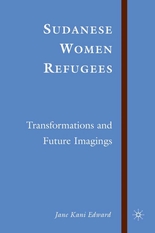|
Reviewed by Jennifer L. De Maio, Ph.D., Assistant Professor, Political Science at California State University, Northridge Women and children comprise the overwhelming majority of the world’s population that has been uprooted by war, yet they remain largely absent in the literature. In her book Sudanese Women Refugees: Transformations and Future Imaginings, sociologist Jane Kani Edward gives voice to Sudanese women refugees who have been misrepresented, marginalized, or ignored in Sudan’s national discourse and, in doing so, takes on the flawed treatment of women refugees as victims in literature as a whole. In doing so, Edward makes an important contribution to the discourse as she challenges the victimized and dependent image of African women refugees by invoking their power, agency, and placing them at the center of the study. To focus her analysis, Edward considers the experiences of southern Sudanese women who have found refuge in Cairo, Egypt. More specifically, she examines the social, cultural, economic, and political transformations that have occurred among these women as they navigate the challenges of life as refugees. Edward dismantles the claim that these women are victims of circumstance who are dependent on their host country and on foreign aid to improve their lives. Instead, she utilizes a conceptual framework rooted in African feminism, black feminism, and antiracial and critical race theory to argue that these women use their newly acquired skills and knowledge to challenge their past and challenge the image of women refugees as victims and dependents in refugee literature. Edward bases her research in Cairo, Egypt because of the high concentration of Sudanese refugees present there and because of the relative safety and accessibility of the city. Her dual-pronged qualitative research approach relies on in-depth interviewing to investigate the lived experiences of women refugees and on group discussion with the aim of generating insights and discussions on common themes and issues affecting all refugees. In addition to arguing that women refugees are not merely victims, Edward addresses the problem of treating refugees as a homogenous group and posits that doing so erases the different histories, politics, and experiences of the refugee population. It also renders invisible the differences in class, race, ethnicity, age, (dis)ability, and their forms of difference that are critical in determining hosting governments’ responses to the refugee situation in Africa. Indeed, she deconstructs the way refugees have been understood in the literature and claims that viewing the refugee as a “problem” usually tends to shift the focus away from the circumstances and the causes that led to the mass displacement of people in the first place. One of the most interesting contributions of Edward’s work is her use of the conceptual framework of the interlocking and intersecting systems of oppression articulated by African feminists, black feminists, and antiracism and critical race theorists. Her exploration of the interactions between race, ethnicity, gender, class relations, culture, and religion are particularly relevant to understanding the host population’s attitude toward Sudanese refugees. Her study of Sudanese women refugees thus has both empirical and normative relevance. The analysis helps fill the empirical gap that exists in the contemporary field of refugee forced migration literature. Edward highlights the ignored contributions and achievements of southern Sudanese women refugees, evoking the power and agency of these women and their resistance to a dependent image of the refugee. By doing so, she makes a valuable addition to the literature on women refugees in Africa. Edward conducted her field research in late 2001, approximately three years before the Comprehensive Peace Agreement (CPA) was signed. In an epilogue, she considers the issue of the return of the refugees in Egypt to Sudan. As the conflict in Darfur rages on and the threat of renewed violence between the north and south looms large, it would be interesting to revisit the refugees interviewed for her study to see what impact, if any, the signing and failing implementation of the peace agreement has had on their perspectives and on the relationship between refugee and host. With its accessible writing style and cogent treatment of an extremely salient issue, Edward’s book will be useful for educators from various fields, including sociology, anthropology, and political science as well as policymakers, aid organizations, and refugee agencies. The book is especially relevant and important for southern Sudanese women refugees who will have the opportunity to see themselves not as victims but as agents of social action and change. |


 Sudanese Women Refugees: Transformations and Future Imaginings
Sudanese Women Refugees: Transformations and Future Imaginings